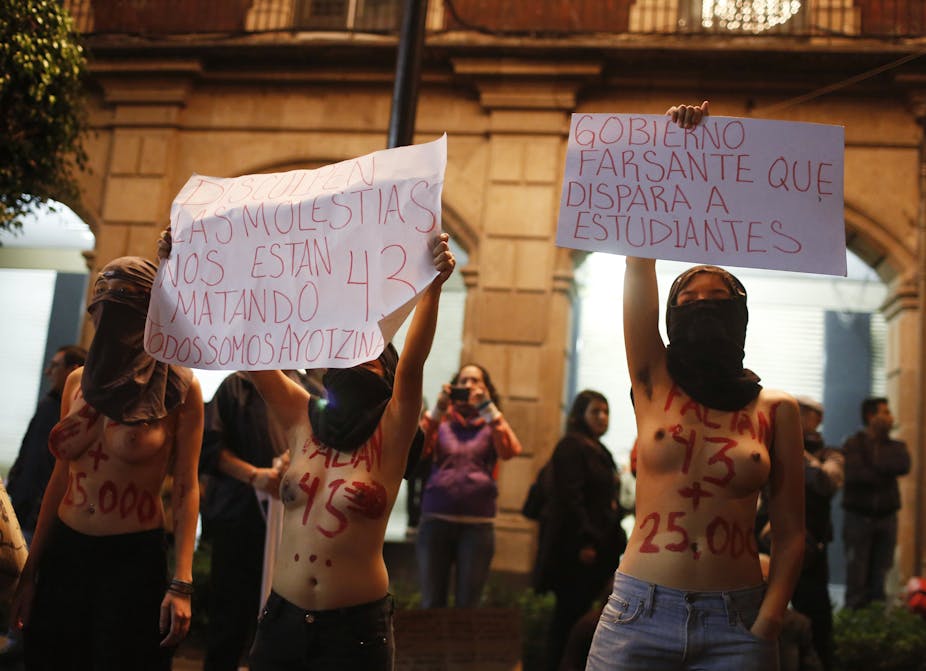Most murders in the United States are well hidden. Popular tourist cities like Chicago, New Orleans and Washington D.C. have homicide rates substantially higher than the national average. At times they approximate the per capita murder statistics of Mexico, Honduras and Brazil, though in the United States these deaths are usually confined to very specific, very poor neighborhoods. They provoke little national outrage and no significant mobilizations outside the communities themselves.
In Mexico, however, violence is harder to compartmentalize and hide. And, in stark contrast to the United States, murder in Mexico is usually assumed to have some direct connection to the Mexican government. A recent example of this has ignited the most powerful wave of simultaneous and widespread protest movements in recent Mexican history.
43 college students disappeared
On the night of September 26, local police in the town of Iguala, Guerrero – allegedly at the behest of the mayor, José Luis Abarca – detained a group of students who were passing through on their way to Mexico City from their rural school in Ayotzinapa.

Forty-three were taken by police and rendered to members of the Guerreros Unidos gang and drug-trafficking organization who, according to the confessions of several of their ranks who were subsequently arrested, killed the students and burned their bodies on a pyre of tires in the city dump.
To those in the United States who maintain an unflinching credulity in the legitimacy of the “State”, this particular kind of violence is incomprehensible at worst, or at best only legible within the threadbare stereotype of Latin American “corruption”.
To those in Santiago de Chile and Buenos Aires who have staged marches in solidarity with the missing students, the experience of government-sponsored disappearances and unaccountability is all too familiar from their own recent history.
It is now over a month since the disappearance of the students. But their bodies are still unidentified and, despite sporadic arrests, there remains throughout Mexico a residue of rank dissatisfaction.
Mass protests
What happened in Iguala is disturbing because it is both a savage act and a betrayal of democratic governance.
It is revealing that protesters in Mexico have largely focused their ire not on the murderers themselves and the infestation of criminal syndicates throughout Mexico, but rather on multiple levels of the Mexican government.
On October 22, thousands of activists in Mexico City marched under the slogan “¡Fue el Estado!” (It was the State!) and, on November 8, thousands more declared “¡Ayotzinapa vive! El Estado ha muerto” (Ayotzinapa lives! The State is dead).
But what and where is the Mexican state? Did it break down at the level of Iguala’s municipal police and their gangland collusions? Or rather in Guerrero’s statehouse? Or perhaps, as many have claimed, does responsibility lie with the president of the republic, Enrique Peña Nieto?
As is typically the case, whether in regard to the mysterious deaths of hundreds of young women in the border town of Ciudad Juárez in the 1990s, the catastrophic spike in drug-related killings after 2006, and now the disappearance and likely execution of students, the vagaries and inconsistencies surrounding violence in Mexico are maddening.
While many claim that the government is not doing enough to enforce the rule of law, others criticize it for its complicity in the killing. The Mexican Army has increasingly taken over local police departments to root out corruption, but is itself constantly plagued by accusations of human rights violations. In response, civilians continue to form armed self-defense groups that are designed to perform many of the functions law enforcement agencies can’t or won’t do.
Heirs to the Mexican Revolution
The young victims in Iguala were students, though “student” does not capture the full meaning of their political and educational formation. They were “normalistas”, loosely translated as “teachers in training”, but that still does not convey the place they held in the Mexican political tradition.
After the armed phase of the Mexican Revolution during the 1910s, the new revolutionary government started building so-called normal schools in the 1920s to help enact the egalitarian mission for which so many revolutionaries had fought.
Teachers, especially rural teachers like the ones trained at the normales, have been at the heart of radical social movements ever since. For nearly a century they have focused their efforts on breaking down social hierarchies and exposing social injustice.
The normalistas were the heirs to the purported mission of the Mexican Revolution. They carried the mantle of the revolutionary state and its core ideals. They were traveling from poor, rural Guerrero to Mexico City to celebrate the anniversary of their urban forebears, the activist students shot down in the Plaza de Tlatelolco in 1968.
For the current-day protesters all over Mexico, whose numbers have by all accounts exceeded any in recent memory, the state has died twice: once with the normalistas themselves who represented the highest aspirations of the Revolution, and again with the modern Mexican government’s perceived betrayal of the Mexican people.

